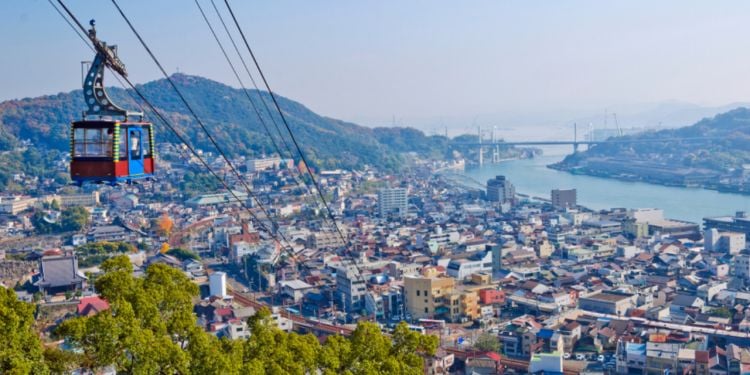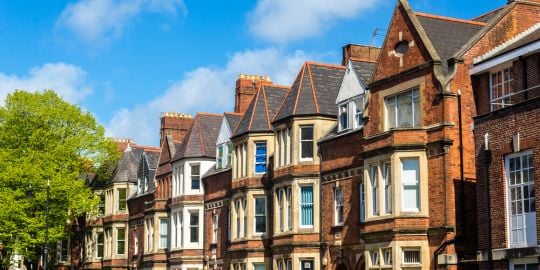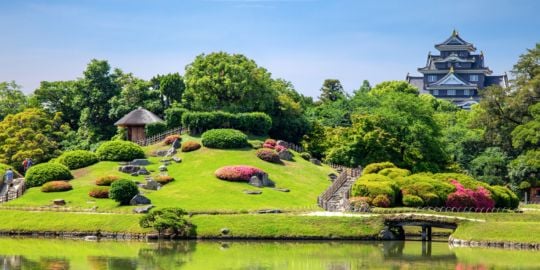Accommodation in Hiroshima

You're in Japan, leaving Tokyo, the megalopolis capital behind, moving further south, towards Hiroshima. And you are looking for accommodation, wondering what to choose between a room in a guesthouse/ share house, an apartment? Which town to choose? Here's a practical guide to finding accommodation in Hiroshima.
Living in Hiroshima: the prefecture or the city?
Before focusing on the housing offers in Hiroshima, you're advised to get familiar with some geographical facts. Hiroshima prefecture is located in the southwest of Honshu, the main island of Japan. Japan is an archipelago composed of 5 main islands: Hokkaido in the north, Honshu, Shikoku, Kyushu, and Okinawa in the south. In addition to these 5 main islands, there are many islands and islets, some inhabited, some not. But let's get back to Hiroshima.
The Hiroshima prefecture faces the island of Shikoku. It is bordered by 4 other prefectures, namely Okayawa in the east, Tottori in the northeast, Shimane in the north and Yamaguchi in the southwest. Hiroshima which is separated from the Shikoku Island by the Seto Inland Sea, is home to 2.7 million souls, most of whom (1.2 million) live in Hiroshima, the city. It is also the capital of the eponymous prefecture. So you can live in Hiroshima Prefecture, or in the capital city, Hiroshima. It's all up to you.
Other important cities of the prefecture
The second biggest city is called Fukuyama, located in the southeastern part of the territory, not far from the border with Okayama prefecture. It is home to 460 930 inhabitants, far from the 1.2 million in Hiroshima. The coastal city of Kure lies in the southwest and has 214,592 inhabitants. Higashihiroshima, which is located in the south of the prefecture, has a population of 196 608. The remaining cities have populations ranging from 130,000 to 50,000. The prefecture is divided into districts: Aki in the south, Jinseki in the northeast, Sera in the center, Toyota in the south, and Yamagata in the northwest.
Districts of Hiroshima city
Let's close up on the city of Hiroshima. In this guide, we will mainly focus on the capital city, which is the economic heart of the prefecture. Hiroshima city is divided into 8 districts, ("ku"s in Japanese): Asakita-ku, in the north, is the biggest district but is not the most populated. One hundred thirty-eight thousand nine hundred seventy-nine people were living there in 2020. On the other hand, 247,020 people prefer to live in the most populated district called Asaminami-ku, which is located just below Asakita-ku.
Good to know:
"Kita" means "north", "minami" means "south", "asa" means "morning" or east if you prefer.
Nishi-ku (the western district), is located south of Asaminami and is home to 190,232 souls. Then comes Minami-ku (the southern district) with its 145,805 inhabitants. In between, you will find Naka-ku (central district) with 142,699 inhabitants.
East of Nishi-ku lies the Saeki Precinct, with 139 563 inhabitants. Southeast of Asakita, Higashi Precinct (Eastern Precinct) has a population of 119,353. And the last borough, Aki, is located in the south of Higashi-ku and also borders the Minami district. Aki-ku has a population of 77,103. (Source: Statistics Bureau of Japan)
If you would like to live closer to the city center and enjoy an urban ambiance, Asaminami-ku, Nishi-ku and Minami-ku are the perfect choices. On the other hand, if you prefer quieter and less populated areas, Aki-ku and Higashi-ku will suit you better.
It is very important to take the time to understand how the Japanese territories are divided administratively. It is not necessary to know everything on the tip of your fingers. It' s just a matter of grasping the way Hiroshima prefecture and city are divided, to better know where to look for a place to live.
City of Hiroshima
Motomachi Ward, in Naka-ku
The Naka Ward in Hiroshima City is known as the heart of the city. Tourists are often advised to book a hotel room in Motomachi, which is in Naka-ku. This is where the Hiroshima Castle and the Peace Memorial are located. Other prestigious sites, museums and cultural properties are located in Motomachi or in the surrounding area. On a different note, Motomachi shopping street is, as its name may suggest, a street entirely dedicated to shopping, with much emphasis on design items, decoration, and souvenirs.
The Nakamachi Ward, in Naka-ku
We are still in Naka district, and Nakamichi is the coolest area of the city, with bars, attractions, clubs and restaurants. The ward is dynamic, and cool, with a particularly active night scene. However, this does not affect the quietness; quite the contrary. Nakamachi has it both ways and is suitable for night owls as well as for those looking for peace and quiet.
The Hijiyamahonmachi Ward in Minami-ku
Let's now head for Minami district. If you decide to go to Hijiyamahonmachi, you will discover a green district. Hijiyamahonmachi is indeed one of the greenest districts of the city, with parks, running paths and everything to satisfy joggers, walkers and families. The place is also known for being a family-friendly ward. This is really good to know if you plan to move to this neighborhood with your family.
Hiroshima Prefecture
Fancy the countryside? Let's take a look at Hiroshima prefecture and reconnect with nature. Akiota is a small town in the Yamagata district, northwest of the prefecture. People are drawn to it because of its peaceful environment, which makes it ideal for raising children. In fact, the town boasts of its infrastructure and its child-friendly environment. Shobara, the hidden village in the north of the prefecture, is one of the oldest villages in Japan. Its inhabitants live in harmony with nature. The village's beauty and authenticity are due to its rich and preserved nature. Following recent media coverage in 2020, the village keeps attracting foreign tourists. But for its inhabitants, there is no question of turning Shobara into a polluting attraction. To keep the calm and serenity of the place, they bet on green tourism.
Types of accommodation in Hiroshima
Whatever the country you live in, choosing your accommodation is both an adventure and an investment. Before considering home decor, some questions must be asked, like:
- How long will you be in the area (in this case, in the prefecture or city of Hiroshima)?
- What is the purpose of your trip?
- Are you an expat on a job contract and intend to leave upon completion of your tasks?
- Are you an immigrant who is settling down for a very long time, or even for their whole life, or are you just a short-term visitor, a business traveler?
- What is your budget?
- Are you looking for a job or have you already found one?
- What are your needs?
- Do you prefer the city or the country?
- Do you need to adapt accessibility to your home, for a wheelchair or medical bed, for example?
The answers to these questions will allow you to better refine your search.
The different home configurations in Japan
This small list will be very useful for your accommodation search. In Japan, the different home configurations are referred to with the following labels:
Number (1): indicates the number of bedrooms
Letter R (room): it means a room
Letter L (living room): refers to the living room
Letter D (dining room): refers to the dining room
Letter K (kitchen): refers to the kitchen
For example, you will find ads that read: "1LDK", "1R", "2LDK".
1LDK means that the accommodation has one bedroom (number 1), and the living room/dining room/kitchen combination.
2LDK means that the accommodation has 2 bedrooms and the combination.
1R is the smallest accommodation one can find and offers only one bedroom. This type of offer can be interesting, especially if you are looking for a small studio or a sharehouse. You have your own room, plus the common shared areas that include toilets, bathrooms, kitchen and living room.
How to measure the area of your home in Japan?
In Hiroshima, as elsewhere, housing located downtown tends to be more expensive than accommodation in the suburbs. The area is also a factor. For the same price, you can either get a small apartment in the heart of the city or a larger apartment, or even a house in rural areas. But how do we measure the size of a property in Japan?
Traditionally, surface area is measured in a unit called "jo". This is the size of a tatami mat. As a matter of fact, traditional Japanese homes usually have at least one room with an entire floor made out of tatami (a traditional Japanese carpet used for flooring).
1 jo is about 1.62 m2. For example, a room of 7 Jo = 11.34 m2. But you'll see that most ads have adopted the universal counting system, in m² that is. So don't panic. You will have no trouble deciphering the surface area of your home. However, pay close attention to that, especially if you choose a very small apartment. You could end up with a small room of 5m². This type of advertisement is more common in Tokyo, where the population density is much higher than in Hiroshima.
Rent prices in Hiroshima
Apartments
In Japan, apartments are called "apa-to" or "mansion". The price range for a 33m² 1DK apartment, that is, for one bedroom, dining room, and kitchen, can range from about 27,000 yen per month to over 40,000 yen without utilities. It really depends on the location in the city and the area you choose to rent. In Higashihiroshima, for example, you can find 33m² 1DK for about 26,000 yen per month without utilities. In downtown Hiroshima, prices can go up to 50,000 or 60,000 yen per month. But you can also find very good deals in Hiroshima city, such as an 80m² 3LDK that includes 3 bedrooms the living room, dining room, and kitchen combo, for 72,000 yen per month, including utilities (69,400 yen rent 2600 yen utilities per month). To have a parking space, you will need to pay 7810 yens on top per month.
Keep in mind that these are only average estimates. Prices can vary by as much as double depending on the type of property you are looking for, and your search area. Also, keep in mind that the price ranges presented below are for unfurnished properties, and this is often the case in Japan, but prices may also come with or without utilities. You may also need to pay a guarantee. For a good deal in Hiroshima, especially in the Nishi district, expect a deposit of about 140,000 yen, which is totally refundable.
Houses
The price for houses can vary according to many criteria, including the surface area, having a garage/garden/balcony, the number of bedrooms, etc. For example, you can find a 92m² 3LDK (3 bedrooms dining room, living room, kitchen), unfurnished, with garage in Higashi district (Hiroshima city) for about 52,000 yen per month.
Studios and sharehouses
The same logic applies to renting a small studio or a room in a sharehouse or guesthouse. In the south of Hiroshima city, you can find a room in a sharehouse for as little as 40,000 yen per month. Prices will vary according to the location of the residence and the options it offers, such as bicycle parking, laundry room, coworking space, unit sizes, and so on.
Hotel or “ryôkan”
Visiting Hiroshima? And you want to stay in a hotel or a “ryôkan” (traditional Japanese inn)? Here again, prices will vary according to the standard you are looking for. For a one-month stay in a luxury “ryôkan” located in Miyajima, you can expect to pay more than one million yen. For a cheap hotel in Hiroshima, count around 70,000 yen per month. Once again, you can find more or less expensive hotels depending on your criteria.
How to find accommodation in Hiroshima
Finding a real estate agency
Whether you choose a traditional real estate agency or one that specializes in dealing with foreigners, you will find the same search options on their websites, namely by price, year of construction, ease of access to metro/train station, surface area, agency fees, facilities and services available like parking, bicycle parking, courtyard, laundry room, etc. Some websites also offer to filter your search by whether or not a property accepts pets. In Japan, it is better to check the details of your rental contract before adopting a pet. Many accommodations still do not allow dogs, cats, and other pets.
Traditional real estate agencies
In Japanese, a real estate agency is called "fudôsanya". The real estate agent is the "fudôsan". To start your search, consider real estate agency websites like Fudosan Honpo, Daiwa kosan or Ieyasu. Unfortunately, these websites do not have an English version. You might also want to look around the area/city where you want to live. There are most likely several local agencies that can help you narrow down your search. Then again, there is little chance that they will speak English. Hence the need for you to speak Japanese.
Agencies that specialize in renting to foreigners
GaijinPot, Village house, Apartment Japan, Wagaya Japan, Japanese guesthouses, Hirogaru, Tento mushi, Sharesite, etc., are among the many agencies that specialize in renting or selling to foreigners. In general, their websites are in English and sometimes offer multilingual versions. Within the agency itself you may find a multilingual staff. This is the case, for instance, with Fontana Tokyo Apartment or OAK house, but neither of these two agencies offers real estate in Hiroshima prefecture.
Buying property in Japan
If you are wondering whether a foreigner can buy a house or an apartment in Japan, the answer is yes. You may even qualify for a loan, depending on your visa. There are several options available.
In Japan, individual houses are called "ikkodate". If you want to build your own house, you can go to a "house maker", a real estate agency specializing in custom-made houses. You can also choose to buy a new house, or an old one. However, you will not be able to apply for a loan with a Japanese tourist visa, student visa or work permit. You will need a work or permanent residence visa. The longer the duration of your visa, the more confident the banks are. Of course, they will also take into account your salary, your starting capital and your ability to repay.
Tips for choosing accommodation in Japan
Whether you have chosen Hiroshima or another region of Japan, be careful about the condition of your property. Very old houses are, not surprisingly, much cheaper. But they may not be earthquake-proof. The same caution applies to homes below sea level, on the seashore; some areas are sometimes flooded during the rainy season.
Formerly a major importer of asbestos, Japan only completely banned this product in 2012. If you buy or rent a property built before that year, check if it is asbestos-free or not. The information does not always appear on the websites of the agencies.
If possible, make several visits to your future neighborhood at different times of the day.
Useful links:
Websites in English
Websites in Japanese









